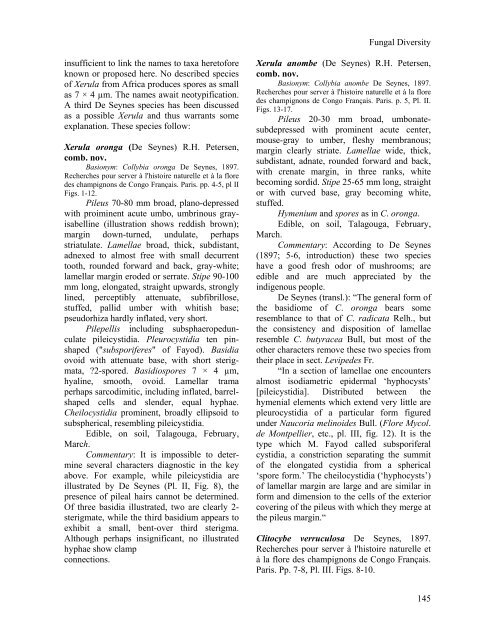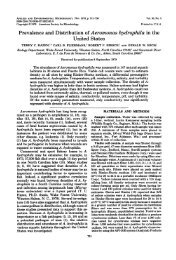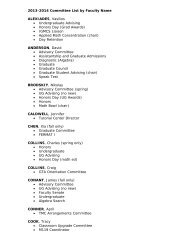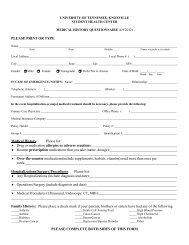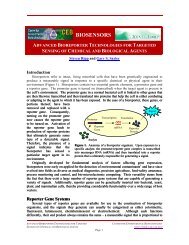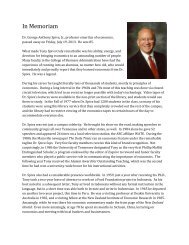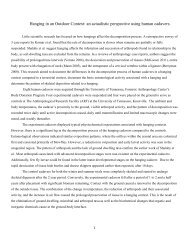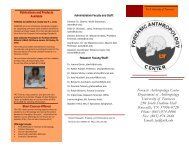Species of Xerula from sub-Saharan Africa
Species of Xerula from sub-Saharan Africa
Species of Xerula from sub-Saharan Africa
Create successful ePaper yourself
Turn your PDF publications into a flip-book with our unique Google optimized e-Paper software.
Fungal Diversity<br />
insufficient to link the names to taxa heret<strong>of</strong>ore<br />
known or proposed here. No described species<br />
<strong>of</strong> <strong>Xerula</strong> <strong>from</strong> <strong>Africa</strong> produces spores as small<br />
as 7 × 4 µm. The names await neotypification.<br />
A third De Seynes species has been discussed<br />
as a possible <strong>Xerula</strong> and thus warrants some<br />
explanation. These species follow:<br />
<strong>Xerula</strong> oronga (De Seynes) R.H. Petersen,<br />
comb. nov.<br />
Basionym: Collybia oronga De Seynes, 1897.<br />
Recherches pour server à l'histoire naturelle et à la flore<br />
des champignons de Congo Français. Paris. pp. 4-5, pl II<br />
Figs. 1-12.<br />
Pileus 70-80 mm broad, plano-depressed<br />
with proiminent acute umbo, umbrinous grayisabelline<br />
(illustration shows reddish brown);<br />
margin down-turned, undulate, perhaps<br />
striatulate. Lamellae broad, thick, <strong>sub</strong>distant,<br />
adnexed to almost free with small decurrent<br />
tooth, rounded forward and back, gray-white;<br />
lamellar margin eroded or serrate. Stipe 90-100<br />
mm long, elongated, straight upwards, strongly<br />
lined, perceptibly attenuate, <strong>sub</strong>fibrillose,<br />
stuffed, pallid umber with whitish base;<br />
pseudorhiza hardly inflated, very short.<br />
Pilepellis including <strong>sub</strong>sphaeropedunculate<br />
pileicystidia. Pleurocystidia ten pinshaped<br />
("<strong>sub</strong>sporiferes" <strong>of</strong> Fayod). Basidia<br />
ovoid with attenuate base, with short sterigmata,<br />
?2-spored. Basidiospores 7 × 4 µm,<br />
hyaline, smooth, ovoid. Lamellar trama<br />
perhaps sarcodimitic, including inflated, barrelshaped<br />
cells and slender, equal hyphae.<br />
Cheilocystidia prominent, broadly ellipsoid to<br />
<strong>sub</strong>spherical, resembling pileicystidia.<br />
Edible, on soil, Talagouga, February,<br />
March.<br />
Commentary: It is impossible to determine<br />
several characters diagnostic in the key<br />
above. For example, while pileicystidia are<br />
illustrated by De Seynes (Pl. II, Fig. 8), the<br />
presence <strong>of</strong> pileal hairs cannot be determined.<br />
Of three basidia illustrated, two are clearly 2-<br />
sterigmate, while the third basidium appears to<br />
exhibit a small, bent-over third sterigma.<br />
Although perhaps insignificant, no illustrated<br />
hyphae show clamp<br />
connections.<br />
<strong>Xerula</strong> anombe (De Seynes) R.H. Petersen,<br />
comb. nov.<br />
Basionym: Collybia anombe De Seynes, 1897.<br />
Recherches pour server à l'histoire naturelle et à la flore<br />
des champignons de Congo Français. Paris. p. 5, Pl. II.<br />
Figs. 13-17.<br />
Pileus 20-30 mm broad, umbonate<strong>sub</strong>depressed<br />
with prominent acute center,<br />
mouse-gray to umber, fleshy membranous;<br />
margin clearly striate. Lamellae wide, thick,<br />
<strong>sub</strong>distant, adnate, rounded forward and back,<br />
with crenate margin, in three ranks, white<br />
becoming sordid. Stipe 25-65 mm long, straight<br />
or with curved base, gray becoming white,<br />
stuffed.<br />
Hymenium and spores as in C. oronga.<br />
Edible, on soil, Talagouga, February,<br />
March.<br />
Commentary: According to De Seynes<br />
(1897; 5-6, introduction) these two species<br />
have a good fresh odor <strong>of</strong> mushrooms; are<br />
edible and are much appreciated by the<br />
indigenous people.<br />
De Seynes (transl.): “The general form <strong>of</strong><br />
the basidiome <strong>of</strong> C. oronga bears some<br />
resemblance to that <strong>of</strong> C. radicata Relh., but<br />
the consistency and disposition <strong>of</strong> lamellae<br />
resemble C. butyracea Bull, but most <strong>of</strong> the<br />
other characters remove these two species <strong>from</strong><br />
their place in sect. Levipedes Fr.<br />
“In a section <strong>of</strong> lamellae one encounters<br />
almost isodiametric epidermal ‘hyphocysts’<br />
[pileicystidia]. Distributed between the<br />
hymenial elements which extend very little are<br />
pleurocystidia <strong>of</strong> a particular form figured<br />
under Naucoria melinoides Bull. (Flore Mycol.<br />
de Montpellier, etc., pl. III, fig. 12). It is the<br />
type which M. Fayod called <strong>sub</strong>sporiferal<br />
cystidia, a constriction separating the summit<br />
<strong>of</strong> the elongated cystidia <strong>from</strong> a spherical<br />
‘spore form.’ The cheilocystidia (‘hyphocysts’)<br />
<strong>of</strong> lamellar margin are large and are similar in<br />
form and dimension to the cells <strong>of</strong> the exterior<br />
covering <strong>of</strong> the pileus with which they merge at<br />
the pileus margin.“<br />
Clitocybe verruculosa De Seynes, 1897.<br />
Recherches pour server à l'histoire naturelle et<br />
à la flore des champignons de Congo Français.<br />
Paris. Pp. 7-8, Pl. III. Figs. 8-10.<br />
145


